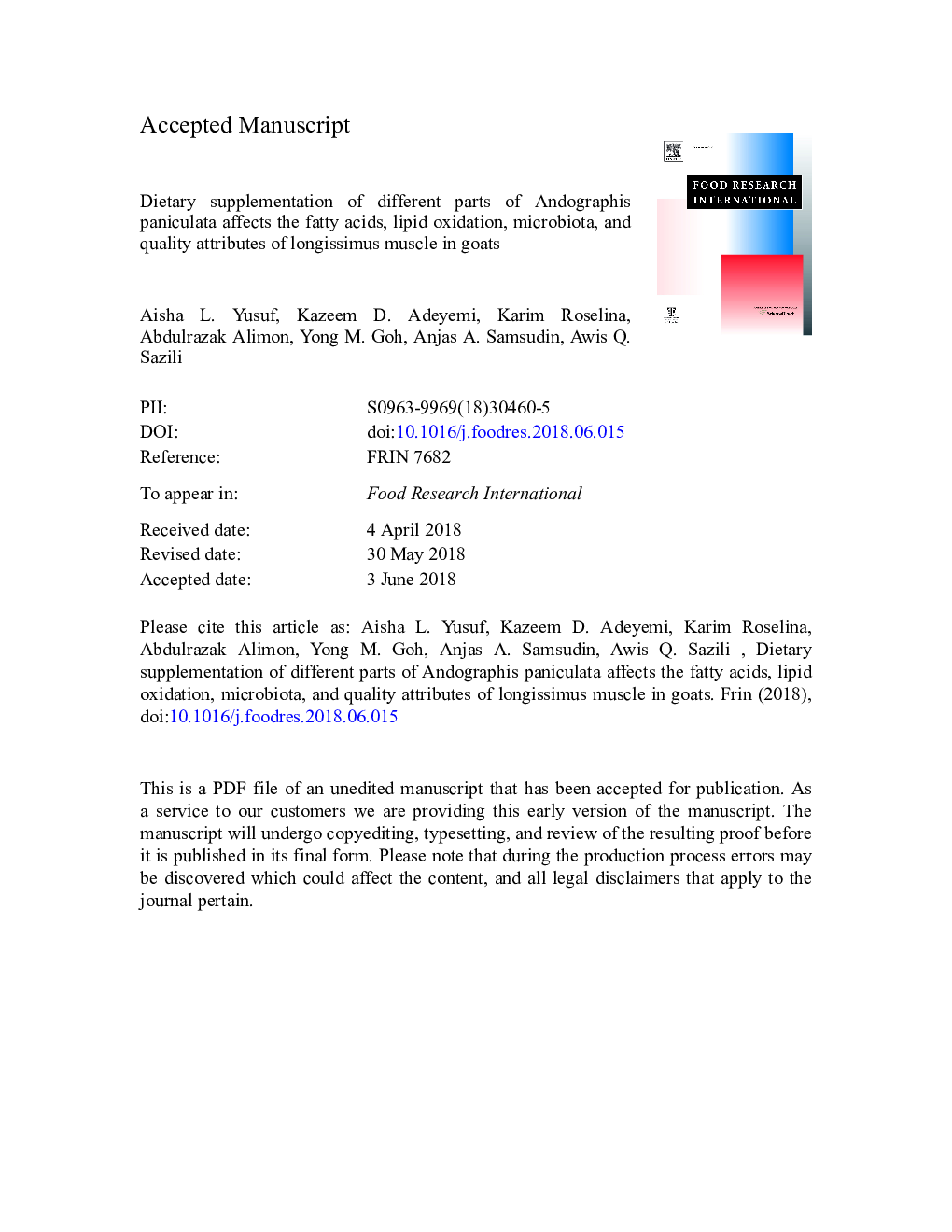| کد مقاله | کد نشریه | سال انتشار | مقاله انگلیسی | نسخه تمام متن |
|---|---|---|---|---|
| 8888869 | 1628440 | 2018 | 39 صفحه PDF | دانلود رایگان |
عنوان انگلیسی مقاله ISI
Dietary supplementation of different parts of Andrographis paniculata affects the fatty acids, lipid oxidation, microbiota, and quality attributes of longissimus muscle in goats
دانلود مقاله + سفارش ترجمه
دانلود مقاله ISI انگلیسی
رایگان برای ایرانیان
کلمات کلیدی
موضوعات مرتبط
علوم زیستی و بیوفناوری
علوم کشاورزی و بیولوژیک
دانش تغذیه
پیش نمایش صفحه اول مقاله

چکیده انگلیسی
The effects of dietary supplementation of different parts of Andrographis paniculata on fatty acids, lipid oxidation, microbiota and quality attributes of Longissimus thoracis et lumborum (LTL) muscle in goats were assessed. Twenty four, entire Boer bucks (4â¯months old; 20.18â¯Â±â¯0.19â¯kg BW) were randomly allotted to either a basal diet without additive (AP0), a basal dietâ¯+â¯1.5% Andrographis paniculata leaves (APL) or a basal dietâ¯+â¯1.5% Andrographis paniculata whole plant (APW). The bucks were fed the diets for 100 d and slaughtered. The LTL muscle was subjected to a 7 d chill storage. The AP0 meat had higher (pâ¯<â¯.05) concentration of C16:0 and C18:0 than the APW and APL meat. The concentrations of total C18:1trans, total CLA, C18:1n-9, C18:2n-6, C18:3n-3 and C20:5n-3 were higher (pâ¯<â¯.05) in APL and APW meat than the AP0 meat. Diets had no effect (pâ¯>â¯.05) on muscle glycogen, pH, drip loss, chemical composition and lactic acid bacteria count. Cooking loss, shear force, and TBARS values were lower (pâ¯<â¯.05) in APL (23.98%, 0.76â¯kg, 0.12â¯mg MDA/kg) and APW (24.53%, 0.80â¯kg, 0.15â¯mg MDA/kg) meat compared with AP0 (26.49%, 1.13â¯kg, 0.23â¯mg MDA/kg) meat. Meat redness was higher (pâ¯<â¯.05) in APL (13.49) and APW (12.98) than AP0 (10.86). Sensory scores for juiciness, tenderness, and overall acceptability of APL (7.92, 7.88, 7.89) and APW (7.90, 7.08, 7.77) meat were higher (pâ¯<â¯.05) than that of the AP0 (5.38, 5.95, 5.41) meat. Total viable counts and populations of Pseudomonas spp, Escherichia coli and Enterobacteriacea were higher (pâ¯<â¯.05) in AP0 meat than in APL and APW meat. The APL exhibited higher (pâ¯<â¯.05) antimicrobial potential than the APW. Chill storage affected (pâ¯<â¯.05) the physicochemical properties, lipid oxidation and microbial counts in chevon. Dietary APL and APW enhanced the beneficial fatty acids, quality attributes and oxidative stability, and reduced microbial counts in chevon.
ناشر
Database: Elsevier - ScienceDirect (ساینس دایرکت)
Journal: Food Research International - Volume 111, September 2018, Pages 699-707
Journal: Food Research International - Volume 111, September 2018, Pages 699-707
نویسندگان
Aisha L. Yusuf, Kazeem D. Adeyemi, Karim Roselina, Abdul Razak Alimon, Yong M. Goh, Anjas A. Samsudin, Awis Q. Sazili,